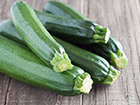what should and shouldnt be next to each other in a garden
Tips & Techniques
Betterdays in Full Swing

Ally Your Flowers and Veggies: Companion Planting Guide to Your Garden
Gardening

By Linda Ly
Gardeners know that a various mix of plants, from annuals and perennials to flowers and vegetables, makes for a healthier garden. Only did you know that the right (or wrong) combination of certain plants could actually make them more than (or less) productive?
The process is known as companion planting. It is believed that growing certain plants in close proximity to others may help deter pests, promote growth and fifty-fifty improve season—or on the reverse end of the spectrum, sure plants, when planted close to one another, may actually stunt each other's growth.
Learn which flowers and veggies work well together, and which ones should be planted far from i another.
What are Companion Plants?
Companion plants are plants that complement ane another in terms of growth and product. For case, one plant may attract an insect that might protect a companion plant. Another plant may act as a repellent for a issues that might be harmful to the plant next to it.
It is also important to look at the nutrients individual plants need. A companion establish may need less of one specific food while its neighbor desperately needs information technology to thrive. In this example, companion planting would eliminate the competition between the two plants.
Benefits of Companion Planting
There are many benefits to companion planting. Most gardeners would concur, the more help you tin get to achieve a productive, fruitful garden, the better! What and how tin companion planting assist?
- Natural Supports – Plants and flowers that grow alpine and strong will lend themselves every bit natural, organic supports to crops that grow low or sprawl. An example of this would be planting tall sunflowers next to cucumbers or snap peas. The sprawling crops can use the taller plants equally a trellis.
- Plant Health – Growing plants next to their companions can meliorate the overall health of both plants. Past eliminating competition between plants, y'all let ane to absorb what it may need without depriving the other. Additionally, as nutrients are pulled from the soil by one plant, the result tin can actually change the entire biochemistry of the soil. And when done correct, the soil can then change or amend the flavor of other plants in the area.
- Optimize Soil – A plant's root organisation can easily affect the soil information technology is in. Plants with long taproots like parsnips and carrots will lift nutrients from the depths of the soil. The nutrients can then do good those plants with shallow root systems. Nitrogen is also important to many plants, and some, such as peas and beans, actually assistance to draw nitrogen in, making it more bachelor in the soil for the plants that need it.
- Preclude Weeds – Alternating upright plants and sprawling ones tin can create a thicker cover beyond the majority of the open state in your garden area, which will ultimately prevent weeds.
- Regulate Shade & Air current – Likewise much sunday can damage tender and fragile plants. Companion planting can help prevent this by offer shelter as taller plants protect smaller ones. The same is truthful for wind. The taller and larger plants will offering protection from harsh winds.
Popular Companion Plants for Vegetables
- Dill and Basil – Dill and basil are natural protectants for love apple plants, keeping away the dreaded hornworm.
- Marigolds – One of the best companion plants out at that place, marigolds help virtually whatsoever vegetable. They are particularly helpful for tomatoes, repelling the nematodes that like to assault the roots of vegetables.
- Mint – Mint repels both ants and cabbage moths.
- Nasturtiums – Nasturtiums help prevent insects, particularly aphids, from attacking other plants. Aphids dear Nasturtiums and will surround them instead of their neighboring plants.
- Sage – Another helpful herb in the garden, sage can protect from cabbage moths.
- Zinnias – Zinnias are splendid companion plants and attract ladybugs into the garden. Ladybugs are known to control unwanted pests similar cabbage flies.
Companion Planting Chart
| Blazon of Vegetable | Friends | Enemies | Special Notes |
Asparagus | Basil, carrots, coriander, dill, marigolds, parsley, tomatoes | Garlic, onions, potatoes | Marigolds, parsley and tomatoes protect against asparagus beetles. |
Basil | Asparagus, beans, beets, bong peppers, cabbage, chili peppers, eggplant, marigolds, oregano, potatoes, tomatoes | Rue | When basil is grown about ane foot from love apple plants, it will increment the tomatoes yield. It too improves the flavor of lettuce. |
Beans | Beets, carrots, chard, cabbage, corn, cucumbers, peas, radishes | Garlic, onions | Nasturtiums and rosemary deter bean beetles |
Beets | Broccoli, Brussels sprouts, bush beans, cabbage, cauliflower, chard, kohlrabi, onions | Charlock, field mustard, pole beans | Pole beans and beets will compete for growth. Composted beet leaves add magnesium to soil when mixed. Magnesium plays an of import role in photosynthesis. |
Broccoli | Basil, beets, bush beans, carrots, celery, chamomile, cucumber, dill, garlic, lettuce, marigolds, mint, nasturtiums, onions, radishes, rosemary, sage, spinach, Swiss chard, thyme | Asparagus, cantaloupe, climbing beans, mustard, peppers, pumpkins, strawberries, sugariness corn, watermelon | Rosemary repels the cabbage fly that is detrimental to broccoli. |
Cabbage | Beets, celery, chard, lettuce, spinach, onions | Kohlrabi, tomatoes | Hyssop, mint, and sage deter cabbage moths |
Carrots | Beans, lettuce, onions, peas, peppers, tomatoes | Dill | Chives meliorate flavour, rosemary deters carrot flies |
Corn | Climbing beans, cucumber, marjoram, peas, pumpkins, squash, sunflowers, zucchini | Tomatoes | Tomato worms and corn earworms like both plants. Beans and peas supply nitrogen. |
Onions | Cabbage, carrots, chard, lettuce, peppers, tomatoes | Beans, peas | Chamomile improves growth and flavor |
Potatoes | Basil, beans, celery, corn, garlic, horseradish, lettuce, marigolds, onions, peas, radishes, spinach | Asparagus, broccoli, Brussels sprouts, cabbage, cauliflower, carrots, cucumbers, eggplant, kohlrabi, melons, peppers, raspberries, squash, sunflowers, strawberries, tomatoes | Cucumbers, tomatoes and raspberries attract harmful pests to potatoes. Horseradish increases disease resistance. |
Pumpkin | Beans, corn, marigolds, nasturtiums, squash | Potatoes | NONE |
Radishes | Beets, cabbage, carrots, chives, cucumbers, kale, lettuce, spinach, squash | Hyssops | Radish plants will piece of work equally a trap crop to protect against certain beetles. |
Squash | Beans, corn, dill, marigolds, nasturtiums, peas, radishes, strawberries, sunflowers | Potatoes | Squash has similar traits to pumpkin in terms of companion plants. |
Strawberries | Bush beans, caraway, chives, lettuce, onions, sage, spinach, squash | Cabbage family, eggplants, peppers, potatoes, tomatoes | NONE |
Tomatoes | Asparagus, carrots, celery, onions, parsley, peppers | Corn, dill, kohlrabi, potatoes | Basil, mint, and bee balm meliorate growth and season |
Zucchini | Beans, corn, dill, garlic, marigolds, nasturtiums, oregano, peas, radishes, spinach | Potatoes and pumpkin | NONE |
Tips for Watering Companion Plants
When growing different varieties of plants side by side, try to group them together by water needs. Deep-rooted vegetables similar tomatoes and asparagus should exist placed in the aforementioned bed, equally they will thrive with less frequent (but more thorough) watering that soaks deep into the soil.
On the flip side, shallow- to medium-rooted plants similar beans and chard do good from more than frequent watering that saturates merely the first few inches of soil. Wind soaker hoses around your plants and attach them to dual outlet electronic timers to easily manage your watering schedule for unlike beds.
Companion planting is a great way to ensure you have a garden that will grow salubrious plants and produce large bounties. A lot of piece of work goes into maintaining a productive garden, and then information technology is worth the time, endeavour and research it takes to grow like-minded plants that will help each other out. And with Gilmour'due south guide to companion planting, we take some of the guesswork out of the process for y'all!

Durable, Flexible Hoses The source of happiness, not hassles.
Our Hoses

Spray Nozzles To fit the need, and your grip.
Our Nozzles

Adaptable Sprinklers H2o your lawn, not the sidewalk.
Our Sprinklers
Source: https://gilmour.com/companion-planting-chart-guide
0 Response to "what should and shouldnt be next to each other in a garden"
Post a Comment